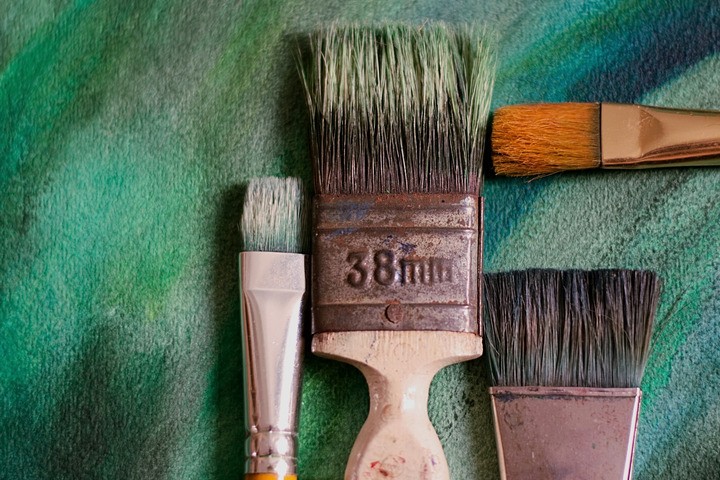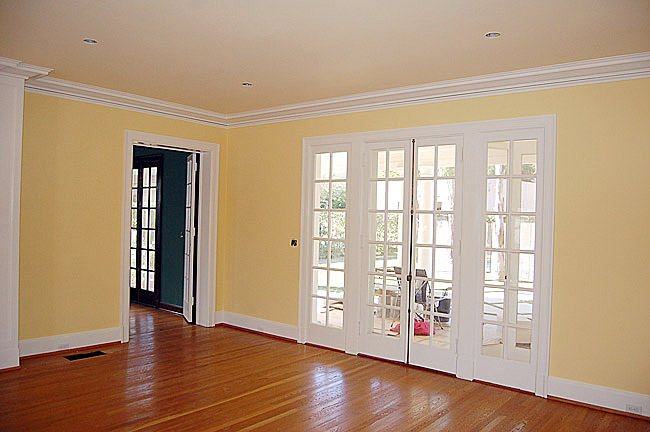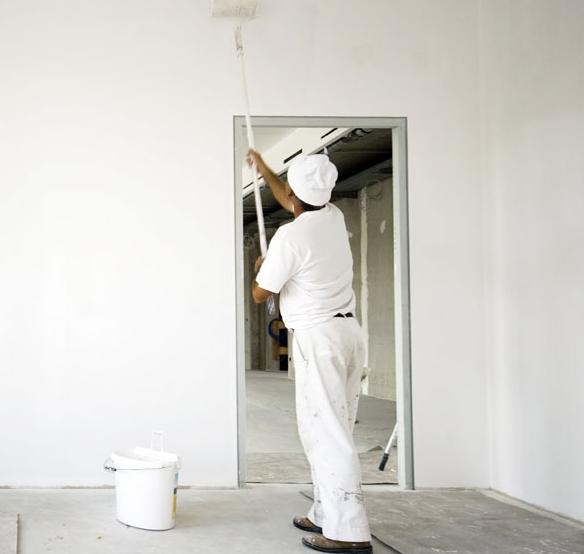Things to Consider When Choosing a Paintbrush
What to consider when choosing the paintbrush for a painting project? The tiniest detail in a paint job can affect the whole result. Surely, you don’t want to discover a blotchy or paint clumps on the wall. So whether you are a homeowner or a property manager planning to hire painters
Type of Paint and the Brush to Use
There are two types of paint: water-based latex paint and oil-based paint. If you need to use latex paint, consider using synthetic non-absorbent bristles. Latex paint’s water component dries more quickly, so it was suitable for areas like walls and ceilings. Compatible brushes for water-based paint include nylon, polyester, mixed brushes, and or combination of both.
Oil-based paint dries up longer than water-based. It can protect the surface against issues like extreme temperature, and rust, mostly the tear and wear situation. Thinner and turpentine can dissolve the oil-based paint, so use it to readjust your colour. Compatible brushes for oil-based paint are the natural absorbent brush like animal fur or fibres, black and white China bristles from hog’s hair and ox hair.
Brush Type
Brush Size and Width: Depends on the level of delicateness in a paint job, there’s an appropriate size to match it.
Narrow and tight areas like windows need smaller paintbrush within 1”-2” width.
Average sized brushes in 1”-4” is usually useful on kitchen doors, cabinets, and countertops.
Bigger paintbrushes with width 4” are for bigger surface areas like wall, ceiling, and rooftop.
Brush Bristles Shape: Angle Sash is for paint trimming, and some from this shape are used to smoothen finish painting. You can use angle brushes to small, tight spaces like doorways, moulding, and gaps. On the other hand, flat brushes often included in the household collection for cleaning purposes. The most popular flat brush is the flag-tipped wall brush.
Quality Brushes. To know if your paintbrush is in good quality, check out some warning signs. The bristles must hold together through the ferrule, or the metal is binding the hair, and nothing should fall off once you pulled the bristles outward.
Type of Surface
Surface Size
If you think that using the bigger paintbrush to a smaller surface can make your job easier and faster, do not be fooled by it. Professional painters always suggest using smaller brushes than the area you need to paint. Small brushes make it more comfortable to press, glide, and you can control the pressure between your hand and the surface.
Surface Texture
The most commonly found in residential painting job are the matte textured wood, concrete walls, and metals. The glossy surface type includes marbles, glass panels, or plastic doors, and tiles. The significant part of combining creativity and practicality is when you need to cover up the jagged areas – instead of smoothening it, the textured paint will do the trick.

Things to Consider When Choosing Paint Colors
Choosing paint colors for your property is a major decision. While you can always change these colors in the future, frequently altering your home’s appearance isn’t cheap, so you want to get it right from the beginning. The colors you choose for your home or business will ultimately depend on your preference, but few people are so decisive. Careful planning and forethought are required
How Will it Look With Your Current Decor?
Choosing colors is all about context. Your interior painting services may focus solely on painting your walls and ceilings, but these aren’t the only features of a room. Think about the furniture, artwork, and accessories that give the room life and purpose. If you plan on keeping these objects as they are, they can serve as a jumping off point for your color choices. Of course, if you’re going to overhaul the entire space and install new furniture, change the layout, etc., you’ll have to think more holistically about how you want the room to look. In this case, you might start with your paint color instead. The bottom line is, your paint job and decor should complement one another, no matter which comes first.
Don’t Knock Neutrals
When we think about picking paint colors, our minds are trained to turn to bright, saturated hues that make bold statements. However, some subtlety can go a long way. Neutral colors like greys, beiges, and off-whites provide balance to a space and give the eyes a place to rest. If you want your interior painting contractors to incorporate brighter, louder colors, consider including neutral tones as well. In fact, you might begin with a neutral color and then see how other colors interact with it to get the look you want.
Think in Themes
You might be in love with a single color, but most people want some variety in their lives. As such, you’ll probably select a handful of paint colors for your home or business. When doing so, take a broad view, keeping in mind how one color will inform another. In other words, instead of choosing a color, choose a theme or color palette. You might want multiple colors for one room, or you might want each room to have its own look that separates it from the rest. And remember that other aspects of your decor, like your furniture, shades, and bedding, will play into these themes as well.
Light Plays a Role
There would be no color at all without light. It makes sense, then, that different types of lighting affect how we see a single color. We may choose a paint color only to realize it looks different when applied to a surface. This phenomenon must be taken into account when choosing paint colors. Your local interior painters can help you understand the ways in which various finishes and light sources will alter the color’s appearance so you’re not completely kept in the dark.

How to Choose an Interior House Painter
The decision to paint a home’s interior can make a huge difference in the homeowner’s living experience. From making the home more attractive to increasing the overall resell value of the home, the benefits are almost endless. This is why it is so important to choose the right interior house painter for the project. The right painting contractor can perfect the home’s improvement for expert results.
Choosing the right painter for the job can help to alleviate the stress associated with such a massive undertaking. From choosing the perfect paint color, to choosing the best quality paint, to preparing the home’s surfaces, a professional can lead the project for the desired end results.
For homeowners who have never hired a professional painter before, here are a few steps to make the most educated decision:
Conduct Research. First conduct adequate research to find top house painters in the area. Research can include internet searches or it can be as simple as asking friends and neighbors for recommendations. Homeowners should also check the Better Business Bureau website for the contractor’s rating or search for other online reviews from previous customers on sites
Interview Painters & Request Estimates. The next step is to call the painters directly and schedule a walk-through of the home. During the visit, the homeowner can interview the painter and determine if they will be a good fit for the project. During the interview the painter should demonstrate their expertise in the painting field. They should use technical terminology and should express their knowledge of the paints and materials to be used. They should also articulate what the process will be like when working with them, demonstrating their professionalism and also differentiating themselves from other contractors.
Ask the Right Questions. During the interview the homeowner should ask as many questions as possible to determine whether or not they would like to hire the painter. One of the top reasons for dissatisfaction among homeowners who did not end up with the results they expected, stems from not asking pertinent questions that would qualify the painter as a good fit for the job.

Local businesses, painting contractors
Are you looking for marketing ideas for your painting company? Like nearly all local businesses, painting contractors often face stiff competition when it comes to marketing.
Promoting a business online is getting difficult. It’s not enough to have a website. You need to have a strong social media presence, set-up effective ad campaigns and have a strong long-term promotional strategy in place.
Focus on local search engine optimisation
The way people search for information online has changed a lot over the past few years. Directories, Yellow Pages and Yelp have been superseded by search engines like Google, Bing and social media networks like Facebook and Twitter. Thus, SEO is not just an additional marketing strategy, it’s a compulsory element of online marketing.
In fact, the most essential part of your online marketing strategy is local SEO. If you are thinking about whether you should invest in SEO for your painting company, it’s time to stop thinking and start doing.
The first thing you need for good SEO is a search engine friendly website that is optimised to generate as many conversions as possible. There are many nitty-gritty aspects of the SEO process that you’re probably not going to have the time or the inclination to fuss around with.

Things to Look for in a Quality House Paint Job
The definition of quality can be somewhat subjective. Yet, there are definite parameters that define whether you received a quality house paint job or not. You should be familiar with these things before you hire a painting contractor.
Proper Protection from Paint
In most cases, a painting contractor isn’t working with an empty house. If you are painting the exterior of your house, protecting shrubbery and landscape plantings from paint is very important. Not only is paint ugly on your bushes, it can also harm the plants. Landscaping is an important aspect of curb appeal so you don’t want to have to reinvest in it after you’ve had your home painted.
Proper Pre-Paint Preparation
A paint job will not last if proper pre-paint preparation techniques are not used. Things like silicone, wax, polish, grease and dirt will prevent the paint from adhering properly. Things might look okay for a short while, but when bad weather arrives, it becomes apparent that pre-paint preparation was sloppy.
Caulking
You have the right to expect a painting contractor to caulk holes, window frames and other trim areas that typically require caulking. One of the goals of painting your home is to protect it from the environment. Caulking prevents water from seeping in behind trim and causing extensive damage.
Clean Lines between Separate Paint Colors
all seen painting jobs where the junction between the ceiling and the walls looks messy because color from the walls slopped up onto the ceiling. No professional should walk away from a paint job where the lines between ceiling and trim, or ceiling and wall aren’t straight and clean.